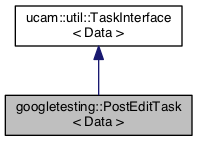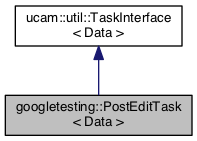googletesting::PostEditTask< Data > Class Template Reference
This is a test to show how an imaginary postedit class could work. The class would contain a pointer to the whole hifst system A single run of PostEditTask may kickoff several times the decoder. More...
Inheritance diagram for googletesting::PostEditTask< Data >:

Collaboration diagram for googletesting::PostEditTask< Data >:

Public Member Functions | |
| PostEditTask (uu::TaskInterface< Data > *fs) | |
| bool | run (Data &d) |
| ~PostEditTask () | |
 Public Member Functions inherited from ucam::util::TaskInterface< Data > Public Member Functions inherited from ucam::util::TaskInterface< Data > | |
| TaskInterface () | |
| Constructor. More... | |
| virtual | ~TaskInterface () |
| bool | chainrun (Data &d) |
| Implements chain of responsability. Calls run method and, if there is another task, call its run method too. More... | |
| bool | operator() (Data &d) |
| TaskInterface & | appendTask (TaskInterface *t) |
| Appends a task class. If there is no task, append here, otherwise delegate in next task. More... | |
| TaskInterface & | operator() (TaskInterface *t) |
| TaskInterface * | getTask () |
| Return appended task. More... | |
| TaskInterface * | next () |
Detailed Description
template<class Data>
class googletesting::PostEditTask< Data >
This is a test to show how an imaginary postedit class could work. The class would contain a pointer to the whole hifst system A single run of PostEditTask may kickoff several times the decoder.
Definition at line 183 of file taskinterface.gtest.cpp.
Constructor & Destructor Documentation
template<class Data>
|
inline |
Definition at line 187 of file taskinterface.gtest.cpp.
template<class Data>
|
inline |
Definition at line 196 of file taskinterface.gtest.cpp.
Member Function Documentation
template<class Data>
|
inlinevirtual |
Implements ucam::util::TaskInterface< Data >.
Definition at line 188 of file taskinterface.gtest.cpp.
Here is the call graph for this function:

Here is the caller graph for this function:

The documentation for this class was generated from the following file:
